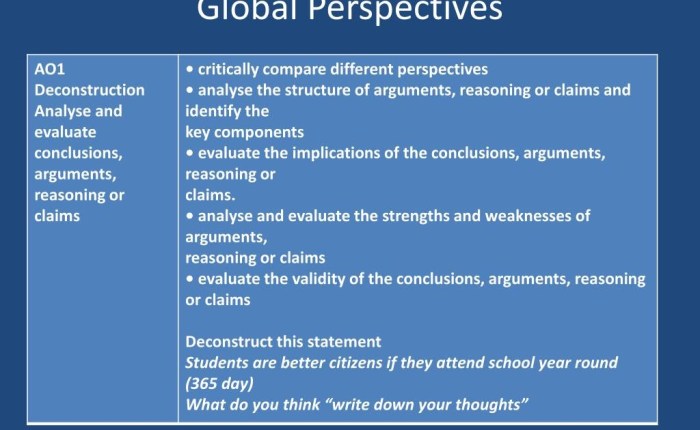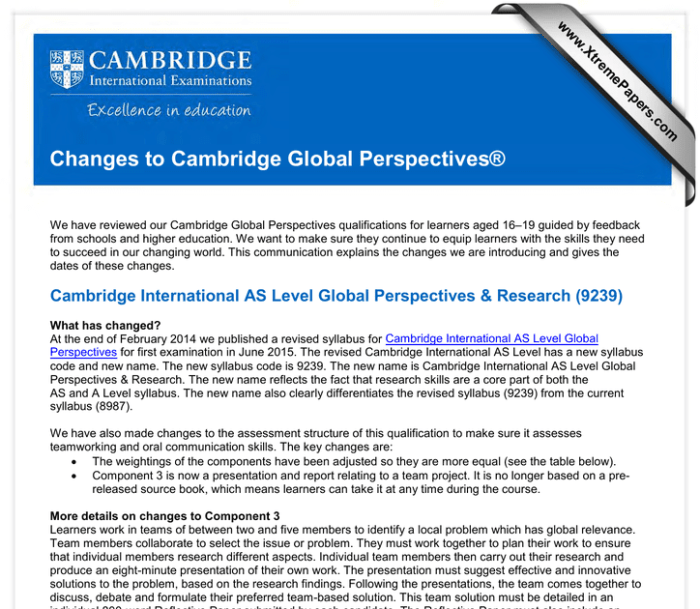Embark on a comprehensive journey through AICE Global Perspectives past papers, uncovering the intricacies of these assessments and empowering students with the knowledge and strategies to excel. This in-depth exploration delves into the exam’s structure, content, and effective study techniques, providing a roadmap for success.
AICE Global Perspectives exams are renowned for their rigorous nature and emphasis on critical thinking and global awareness. Understanding the exam format, question types, and marking scheme is crucial for effective preparation. Past papers offer invaluable insights into these aspects, enabling students to familiarize themselves with the exam’s demands and develop tailored study plans.
AICE Global Perspectives Past Papers
The Advanced International Certificate of Education (AICE) Global Perspectives exam assesses students’ understanding of global issues and their ability to analyze and evaluate different perspectives on these issues. The exam is designed to help students develop critical thinking, research, and communication skills.
The AICE Global Perspectives exam was first introduced in 2004. It is currently offered at over 1,000 schools in over 100 countries.
Availability and Accessibility
AICE Global Perspectives past papers are available on the Cambridge Assessment International Education website. The papers are free to download and can be used for practice or revision.
Understanding the Exam Format

The AICE Global Perspectives exam consists of three sections, each with a specific focus and time allocation. Understanding the format and question types in each section is crucial for effective exam preparation.
Section 1: Source-Based Questions (50%)
- Comprises multiple sources (e.g., texts, images, graphs) related to a global issue.
- Students analyze the sources, identify key arguments, and evaluate their credibility and perspectives.
- Time allocation: 1 hour 30 minutes
- Marking scheme: Assesses analytical skills, source evaluation, and argument development.
Section 2: Extended Essay (30%)
- Students choose one of three topics and write an extended essay (1,200-1,500 words).
- Essays should demonstrate a comprehensive understanding of the topic, critical analysis, and a well-supported argument.
- Time allocation: 2 hours
- Marking scheme: Evaluates research skills, analytical thinking, and writing proficiency.
Section 3: Short Answer Questions (20%), Aice global perspectives past papers
- Comprises 10 short answer questions based on a single global issue.
- Questions test students’ knowledge, understanding, and ability to apply concepts to new situations.
- Time allocation: 30 minutes
- Marking scheme: Rewards concise, accurate, and well-reasoned responses.
Content Analysis of Past Papers

Analyzing past AICE Global Perspectives exam papers provides valuable insights into the key themes, trends, and patterns of the exam content. This analysis helps candidates understand the nature of the exam and prepare effectively.
Key Themes and Topics
Past papers have consistently covered a wide range of global issues and perspectives, including:
- Globalization and its impact on various aspects of society
- Sustainability and environmental challenges
- Human rights and social justice
- Cultural diversity and intercultural understanding
- Economic development and inequality
Trends and Patterns
Over time, certain trends and patterns have emerged in the exam content:
- Increased emphasis on contemporary global issues and events
- Greater focus on the interconnectedness of global challenges
- More complex and nuanced questions that require higher-order thinking skills
Level of Difficulty and Complexity
The level of difficulty and complexity of past papers has varied slightly over the years, but overall, the exam remains challenging.
Questions typically require candidates to:
- Demonstrate a deep understanding of global issues
- Analyze and interpret diverse perspectives
- Formulate well-supported arguments and draw evidence from a variety of sources
Strategies for Using Past Papers

Past papers provide valuable insights into the exam format, content, and assessment criteria. Effective use of past papers can significantly enhance exam preparation.
To maximize their benefits, consider the following strategies:
Selecting Past Papers
- Start with the most recent papers to familiarize yourself with the current exam format and expectations.
- Prioritize papers from reputable sources, such as official exam boards or trusted educational institutions.
- Select papers that cover a range of topics and difficulty levels to ensure comprehensive preparation.
Analyzing Past Papers
- Carefully examine the exam instructions and marking scheme to understand the assessment criteria.
- Identify the key concepts, themes, and skills tested in each paper.
- Analyze the types of questions asked and the level of detail required in the answers.
Learning from Past Papers
- Attempt past papers under timed conditions to simulate the actual exam experience.
- Critically evaluate your answers against the marking scheme to identify areas for improvement.
- Review the papers regularly to reinforce your understanding and identify recurring patterns or concepts.
Sample Questions and Analysis: Aice Global Perspectives Past Papers

Sample questions from AICE Global Perspectives past papers provide valuable insights into the exam format, content, and difficulty level. Analyzing these questions helps students identify potential pitfalls and develop effective strategies for answering them.
Sample Questions
| Year | Question |
|---|---|
| 2022 | Discuss the ethical implications of artificial intelligence (AI) in healthcare. |
| 2021 | Analyze the role of globalization in shaping cultural identity. |
| 2020 | Evaluate the effectiveness of international organizations in addressing global challenges. |
Analysis
The sample questions cover a wide range of topics, reflecting the interdisciplinary nature of AICE Global Perspectives. The questions are generally challenging, requiring students to demonstrate a deep understanding of the subject matter and the ability to analyze and evaluate complex issues.
Potential pitfalls include:
- Lack of specific knowledge about the topic
- Difficulty in organizing and presenting arguments
- Overreliance on personal opinions
Strategies for Answering Questions
To answer different types of questions effectively, students should adopt the following strategies:
- For discussion questions:Provide a clear thesis statement, support arguments with evidence, and consider multiple perspectives.
- For analysis questions:Break down the question into smaller parts, identify key concepts, and provide a structured response.
- For evaluation questions:Assess the strengths and weaknesses of a given approach, use specific criteria to support judgments, and provide recommendations for improvement.
Common Mistakes and How to Avoid Them

Students often make several common mistakes in AICE Global Perspectives exams. Understanding these mistakes and learning how to avoid them can significantly improve exam performance.
One common mistake is failing to understand the exam format and requirements. Students should carefully read the exam instructions and ensure they understand the structure, timing, and marking scheme. This knowledge helps them allocate their time effectively and focus on the most important aspects of the exam.
Lack of Contextualization
Students may fail to contextualize their responses, which means they do not provide sufficient background information or analysis to support their arguments. They should ensure they understand the global context of the issues being discussed and provide specific examples to illustrate their points.
Overgeneralization
Students may make sweeping generalizations without providing evidence to support their claims. They should avoid making broad statements that cannot be substantiated by facts or data. Instead, they should focus on providing specific examples and evidence to support their arguments.
Ignoring Counterarguments
Students may fail to consider counterarguments or alternative perspectives on the issues being discussed. They should demonstrate a balanced understanding of the topic by acknowledging and addressing opposing viewpoints. This shows a deeper understanding of the complexities of global issues.
Lack of Critical Thinking
Students may fail to demonstrate critical thinking skills by simply restating information from the source material without analyzing or evaluating it. They should engage with the material critically, questioning its validity, reliability, and implications.
Poor Time Management
Students may mismanage their time during the exam, leading to rushed or incomplete answers. They should practice time management strategies to ensure they allocate sufficient time to each question and complete the exam within the time limit.
Question & Answer Hub
What is the purpose of AICE Global Perspectives exams?
AICE Global Perspectives exams assess students’ understanding of global issues, critical thinking skills, and ability to apply knowledge to real-world contexts.
How can I access past papers for AICE Global Perspectives exams?
Past papers are available on the Cambridge Assessment International Education website and through various educational resources.
What is the best way to use past papers for exam preparation?
Past papers should be used to familiarize yourself with the exam format, practice answering different question types, and identify areas for improvement.

